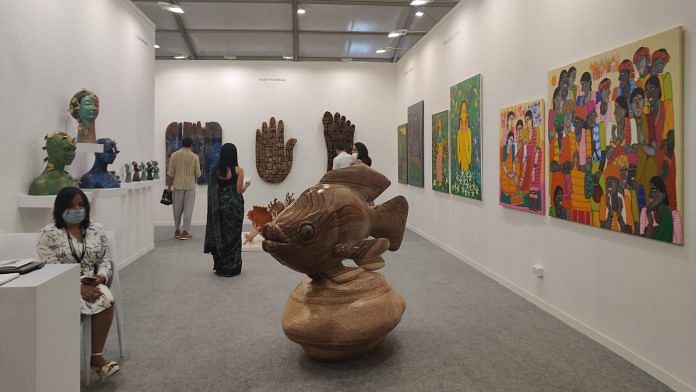New Delhi: Dotted with Braille guides and featuring sign-language interpreters, the 13th India Art Fair (IAF) returned to Delhi this week after a break of two years for Covid.
The four-day event, which kicked off Thursday, is hosting around 79 exhibitors, including 65 galleries and 14 institutional participants at Exhibition Grounds in Delhi’s Okhla area. The India Art Fair is a platform that showcases modern and contemporary art and artists, primarily from South Asia.
“Artists are always influenced by their environment and the social construct of society. Art is definitely a by-product of that. They have responded to the last two years in different ways. Our job is to give them a platform to express themselves with as much freedom as they can,” said Jaya Asokan, director of IAF 2022.
The event was being helmed by Asokan for the first time since taking over as the director of IAF last April. The turnout at the fair was not eclipsed by Covid fears but rather it brimmed with visitors from the morning of the first day.
“There’s a lot of crowds, a lot of pent-up enthusiasm that is coming back. The gallerists are very happy. All in all, it’s a very positive atmosphere,” she added.
Spread across a 12,000 square meter area, the fair consisted of five sections – galleries showcasing Indian and international exhibitors, features displaying presentations of solo artists, institutions focusing on museums and art foundations, a corner for young emerging artists or art practices and outdoor art projects.
“We are really excited to be at IAF. As Emami Art, we have been participating since its inception, I think. Every year, it’s getting more fun to here. To meet other artists, meet gallerists. At my booth, we are showing a lot of young Bengali artists,” said Kolkata Centre for Creativity’s chairperson and CEO of Emami Art Richa Agarwal.
Notable artworks
Emami Art was hosting many artists but one stood out – Ghanashyam Latua from Shanti Niketan who had done a series on “Khoai”, a part of the Chota Nagpur plateau. Explaining the reason behind choosing the subject, the artist said he had witnessed a transformation in the landscape around Shanti Niketan within 10 years due to urbanisation, tourism and housing.
“Here, I am trying to metaphorically execute the realisations about changing landscape I have witnessed,” Latua said.
Latua wasn’t the only one inspired by his environment. The entire theme of the fair was based on sustainability and innovation, which was devised by Asokan in collaboration with Vikram Pawah, president of BMW Group, the presenting partner of IAF.
Under their initiative, ‘The Future is Born of Art’, BMW India unveiled the new i4 electric sedan at the fair. The all-electric car became a canvas for prominent artist Faiza Hasan, whose winning design on sustainability adorned the body of the vehicle.
Acclaimed artist Satish Gujral’s daughter Raseel Gujral, affiliated with the Kiran Gujral Art Initiative, showed her late father’s artwork on burnt wood series (a combination of mixed media – wood, cowrie shells, leather), which as she proclaimed was the expression of the time he lived in.
“My father who was a legendary artist in India as well as among his contemporaries passed away at the beginning of the pandemic in March 2020. As a result, the was no real farewell that we initiated for him then. The art fair was also quiet to host a public function but this year they reached out to us to have an ‘In Memoriam‘ space for our father. So this is the first public outing of his work since he passed away,” Gujral said.
The fair was not limited to looking at artworks, it offered space for workshops and projects, hosted talks by celebrated artists and leading art collectors, along with holding cultural performances and movie screenings.
A welcome change
Keeping up with the changing times, the fair accommodated the needs of differently-abled people. It was an inclusive event dotted with Braille guides, tactile representations of key artworks and featured sign-language interpreters.
Shivani, who was part of an ‘Inclusion Lab’ – which taught visual concepts like drawing to blind children – said this was the first time visually-impaired children were participating in the art fair.
“Blind people are artists like other artists. I am not looking for pity or donations, nothing. If you like the work buy them or appreciate them because this will be a means of employment for them because unemployment among the blind is a big issue in India. I just want to open up earning zone for them. This is a small initiative,” she said.
Also read: Art, anthropocentrism and a mega art fair



